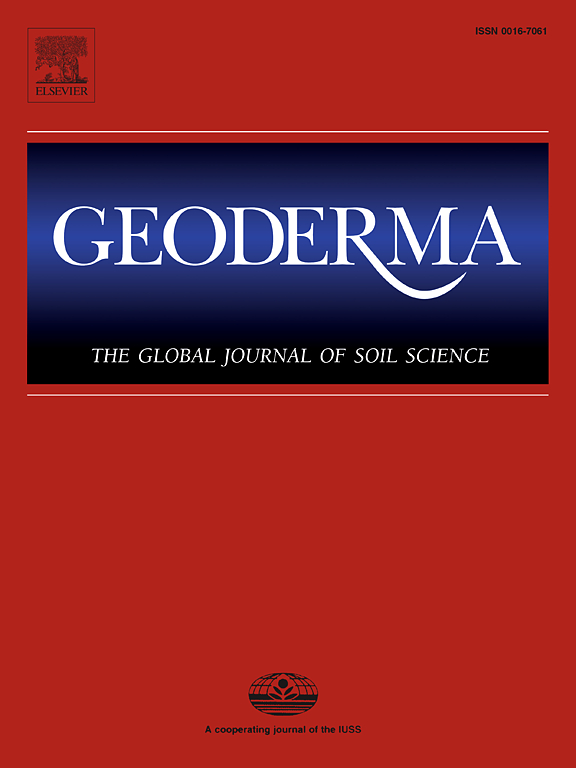河口梯度潮汐沼泽土壤有机碳储量及其稳定机制
IF 6.6
1区 农林科学
Q1 SOIL SCIENCE
引用次数: 0
摘要
河口潮沼储存了大量的土壤有机碳(SOC),受潮汐淹没和盐度与生物生态系统组分的相互作用支配,具有较强的时空异质性。很少有人知道这些河口条件是如何影响有机碳稳定的。我们的目的是评估(i)有机碳储量,(ii)有机碳稳定机制(聚集和矿物关联),以及(iii)它们沿河口梯度的环境驱动因素。我们分析了德国易北河口沿盐度梯度(盐、半咸淡水、淡水)的三种沼泽类型中代表三种洪水状态(日、月、年)的三个沼泽带表层土壤(0-10 cm)和底土(10-30 cm)的有机碳储量和有机碳密度分数。0 ~ 30 cm土壤有机碳储量在9.3 ~ 74.6 t ha - 1之间,随盐度和淹水的增加而减少。这与植物生物量和土壤质地的减少有关。有机有机质(OM)与矿物(CMAOM)构成最大的有机碳组分(59%),其次是聚集体-封闭有机质(CoPOM)(24%)和自由颗粒有机质(CfPOM)(16%)。表层土壤CMAOM含量随盐度的增加而降低,反映了土壤细质地的降低。表层土壤和高湿地的CoPOM含量较高,表明洪水对聚集有负面影响。CfPOM对总有机碳的贡献随着洪水的增加而增加,可能与其在减少土壤条件下的保存有关。我们的研究结果强调,海洋影响的增加(盐度和洪水频率的上升)导致有机碳含量的下降和稳定。因此,海平面上升有可能对河口沼泽的有机碳储量产生负面影响。本文章由计算机程序翻译,如有差异,请以英文原文为准。

Soil organic carbon stocks and stabilization mechanisms in tidal marshes along estuarine gradients
Tidal marshes in estuaries store large amounts of soil organic carbon (SOC) and are dominated by the interaction of tidal inundation and salinity with biotic ecosystem components, leading to strong spatio-temporal heterogeneity. Little is known how these estuarine conditions affect SOC stabilization. Our aim was to assess (i) SOC stocks, (ii) SOC stabilization mechanisms (aggregation and mineral-association), and (iii) their environmental drivers along estuarine gradients. We analyzed SOC stocks and SOC density fractions in topsoil (0–10 cm) and subsoil (10–30 cm) of three marsh zones representing three flooding regimes (daily, monthly, yearly) in three marsh types along the salinity gradient (salt, brackish, freshwater) of the Elbe Estuary, Germany. The SOC stocks in 0–30 cm ranged between 9.3–74.6 t ha−1, and decreased with increasing salinity and flooding. This was linked to decreasing plant biomass and soil fine texture. Organic matter (OM) associated with minerals (CMAOM) constituted the largest SOC fraction (59 % of SOC), followed by aggregate-occluded OM (CoPOM) (24 %) and free particulate OM (CfPOM) (16 %). The CMAOM amount in topsoils decreased with increasing salinity, reflecting decreasing soil fine texture. Amounts of CoPOM were higher in topsoils and high marshes, indicating negative effects of flooding on aggregation. The contribution of CfPOM to total SOC increased with increasing flooding, likely related to its preservation under reducing soil conditions. Our results emphasize that increasing marine influence (rising salinity and flooding frequency) leads to a decrease in SOC content and stabilization. Therefore, sea–level rise has the potential to negatively impact SOC storage in estuarine marshes.
求助全文
通过发布文献求助,成功后即可免费获取论文全文。
去求助
来源期刊

Geoderma
农林科学-土壤科学
CiteScore
11.80
自引率
6.60%
发文量
597
审稿时长
58 days
期刊介绍:
Geoderma - the global journal of soil science - welcomes authors, readers and soil research from all parts of the world, encourages worldwide soil studies, and embraces all aspects of soil science and its associated pedagogy. The journal particularly welcomes interdisciplinary work focusing on dynamic soil processes and functions across space and time.
 求助内容:
求助内容: 应助结果提醒方式:
应助结果提醒方式:


